What to Eat at moko. Beyond Banchan. Modern Korean in Culver City.
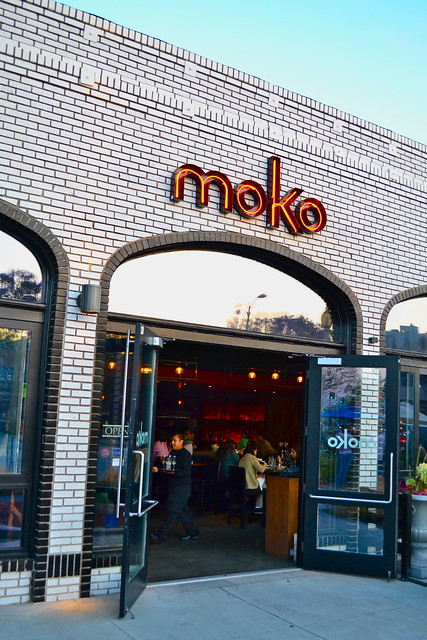
From KBBQ to Modern Korean.
Reinventing Korean dining in Los Angeles is a tough proposition. Although Korean cuisine covers a wide scope in styles, flavors and technique, many diners in LA associate it with one hugely popular and delicious niche ― the Korean BBQ, where famished diners can grill a variety of Korean seasoned (or unseasoned) meats till their hunger is vanquished. Even the Kogi Truck opted to incorporate the most beloved of Korean food, galbi, and snuggled it up inside a fresh corn tortilla for broad appeal.
Really, who can blame anyone for loving freshly grilled, delicious meat served with bottomless banchan, the requisite multitude of tiny side dishes consisting of various vegetables and, sometimes, seafood? If it ain't broke, don't fix it, right?
The people behind moko (the abbreviation for Modern Korean) may not believe that Korean cuisine is broken but, perhaps, the general public's perception of it is slightly myopic. Korean cuisine offers a dizzying array of dining possibilities like soondae, Korean blood sausages bloated with pig's blood and glass noodles, or the Korean royal court cuisine like the virtually endless feasts at YongSuSan.
The Korean stews and noodle dishes are only rivaled by the available army of banchan. There's a lot to be discovered as an adventurous eater. Unfortunately, for many diners Korean food suffers from a quandary (much like Mexican food with tacos and burritos) of getting people beyond the usual rotation of familiar fare of BBQ and banchan.
moko's mission is, in a sense, to introduce diners to other aspects of Korean dining, either traditional or modernist, which is one reason why the principles decided to shutter Gyenari, a traditional Korean BBQ for the most part, and beget Modern Korean. Chef Gary Robins (The Biltmore Room, The Russian Tea Room, Sheridan Square and Aja) is a non-Korean, ex-New Yorker who's embracing the concept of anju, or Korean pub grub, in a big way. These are small tapas-style plates designed for multi-dish sampling while consuming booze, ideally soju.

Quest for Fire Meat.
To really appreciate moko's move beyond the usual selections at Korean BBQs, you need to experiment a little. Try the Apricot Marinated Duck. Toss an Oyster on the barbie, watch it unseal and release its salty juices. Feeling extra bold? Throw the grill a bone. Bone Marrow, that is. A calcium trench clotted with unctuous, slurpy gunk saturated in fatty, meaty flavors. Just make sure it's cooked long enough to achieve a creamy rather than oily consistency. Gently set this nature's butter onto the green onion focaccia and get ready to roll eyes into back portion of head.
The tricky bit about grilling your own food at moko is that the items are not all thinly sliced proteins, some are shellfish, some are meat on bone, meaning each item has its own cooking time and technique. Ask for guidance when in doubt to avoid over or undercooking.
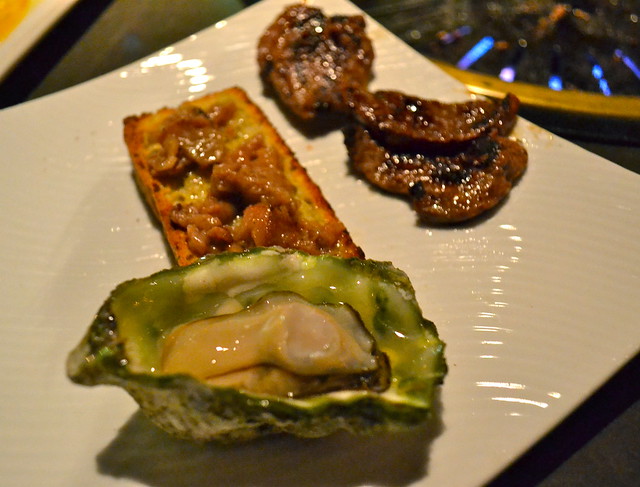
Surf & turf & pond.
The raw fish items are luxurious and simple. Chef Robins visits daily the respected International Marine Produces fish market and makes his choice picks. Each delicate presentation bursted out in bright summer colors and flavors.
The portions of Big Eye Tuna rested on fine slices of cucumber with pieces of sweet blood orange and soaked in yuzu, soy sauce and garlic, everything felt gentle like cool, ocean sheets of velvet basking in everything citrus.
A Fluke transparently cut and simply served with citrus, nori and fresh shoots was a catch of the day. Practically rendered invisible when enveloped by the citrus bath, it was nicely subtle and paired well with the sauce.
Standing out as the big personality, the Hamachi highlighted by an orange citrus foam and dressed with pickled jalapeño and toasted garlic was an edible study in contrast of textures and fusion flavors.

Sashimi a la Robins.
A savory Steamed Shrimp and Scallop Custard was delivered piping hot and heaping with seafood goodies and crowned with a parmesan crisp. The clabbered custard, thick with egg, ginger and seafood flavors, was a variation on a humble banchan known in Korean as Gyeran Jjim or "steamed egg". This custard ate like a rich and hearty mini stew of Dungeness crab, blue shrimp, scallop and shitake.

Crabby custard.
The almost companion plate to the custard of Shrimp and Crab Jeon arrived on a wooden slab fit for a bloody king cut prime rib and served by a wench. What's also known as the Korean pancake, this shellfish jeon is one chewy, starchy, spicy jaw workout. It's embedded with hefty bits of snappy shrimp and crab while smoothed out by slices of avocado topping. The asparagus and spicy greens completed this pancake and turned it into a savory, piquant meal. Very satisfying as well as filling.
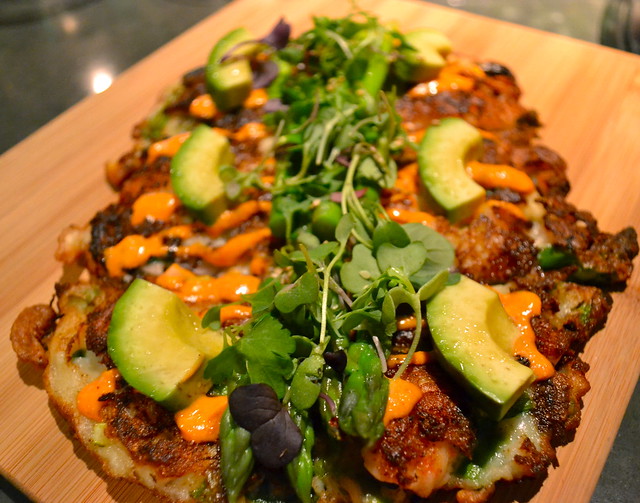
Crab + pancakes = crabcakes!
Skewers are known as "kochi" at moko, and the same attention to ingredients and how flavors play off one another is evident here as well. There was Galbi, Apricot Ginger Glazed Chicken, even a Squash Blossom Tempura skewer, but the one that made it onto my "Last Meal List" was the Crisped Pork Belly & Scallop skewer. Each bite of this surf and turf on a stick showcased just how sweet animal protein can be. Cubes of perfectly fatty pork belly and plump scallops were exquisitely caramelized imparting more sweetness and a slight crunch. With some help from the minted grapefruit and aji amarillo jang, there was no other plate more saturated in luscious goodness than this one. Love this kochi!
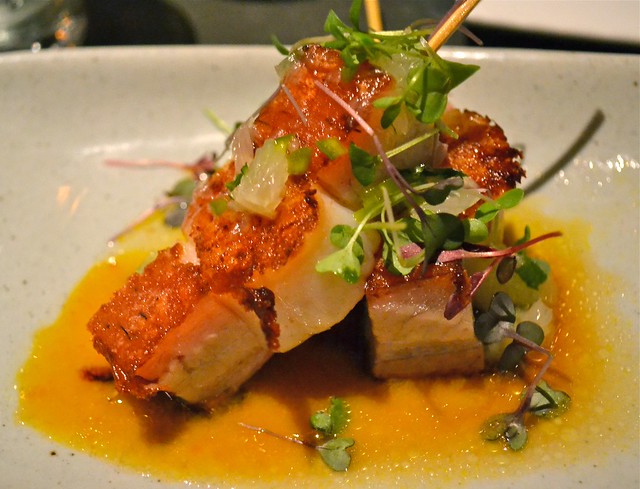
Kochi kochi koo!
According to Yelp! reviewers, most people don't like paying for banchan. In fact, they hate it. (From reading a few choice posts, you'd think it'd be more fun squirting kimchi marinade directly into your eye sockets.) Their unofficial motto: "Eat Free Banchan Or Die". When you're used to getting something for free and as much as you can stomach, why would you want to pay for it? Good question. I mean, I personally wouldn't, especially in this Depression/Recession.
The "Market Banchan", as it has been branded at moko, is quality stuff. The produce, ingredients, seasonings, technique used in creating moko's banchan are noticeably superior to that of your standard gratis banchan at a Korean grillery. The honey braised Sweet Lotus root sprinkled with sesame seeds, Heirloom Tomatoes in a ginger soy vinaigrette, the Purple Eggplant Namul, these are small plates you very likely won't see given away at typical KBBQs.
However delicious and well-crafted, will diners happily fork over 9 bucks for a trio of quality banchan? (And, no, this isn't the kind your mom makes.) Honestly, I would not. I'd rather hand over that cash for a moko cocktail. (Would you call that a "moko cota"? Nevermind.)
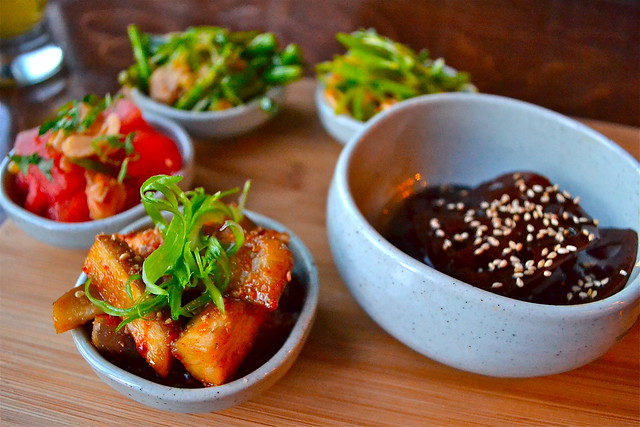
Ban $9 banchan?
While we're talking cocktails, the Ginger Pear Collins is my drink of choice at moko. The vodka based bevvie is a gulp of refreshing ginger and pear with a zap of lemon juice. This Collins has enough muscle to go up against the strong Korean profiles of moko's dishes, so it's an ideal palate reset.
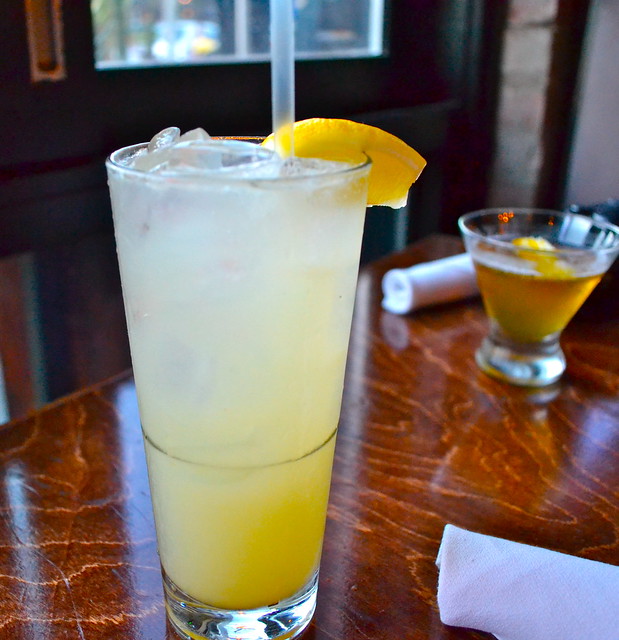
The Korean BBQ palate reset.
Now if you're just one of those Korean grilling diehards and can't go too long without cooking something over a flame, consider ending your moko meal with the moko S'mores.

Who's got a good Korean ghost story?
A trio of scratch made marshmallows with flavors including strawberry, orange-ginger and anise, accompanied by lush E. Guittard Chocolate, almond crisps, graham crackers and, of course, FIRE, FIRE, FIRE, are the most appropriate and whimsical way to end a delicious meal of Korean BBQ reimagined.
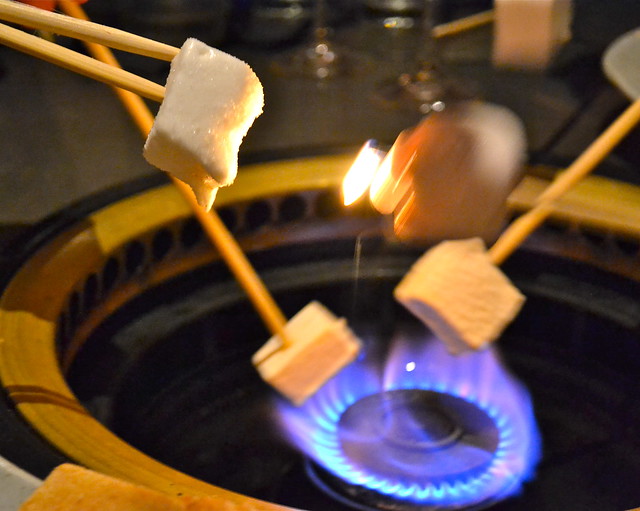
More bulmallows, anyone?
moko
9540 Culver Blvd
Culver City, CA 90232
310.838.3131
Comments